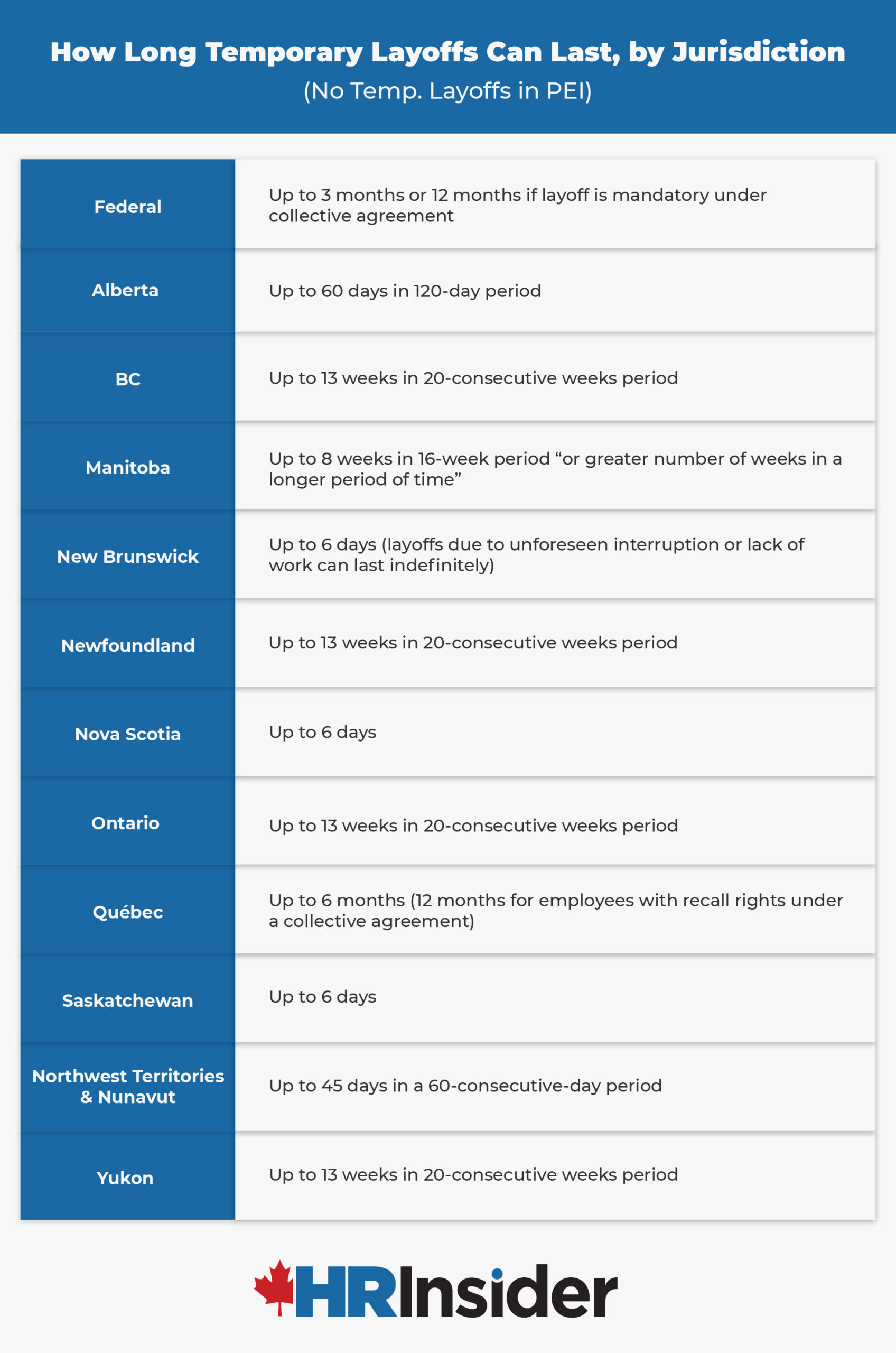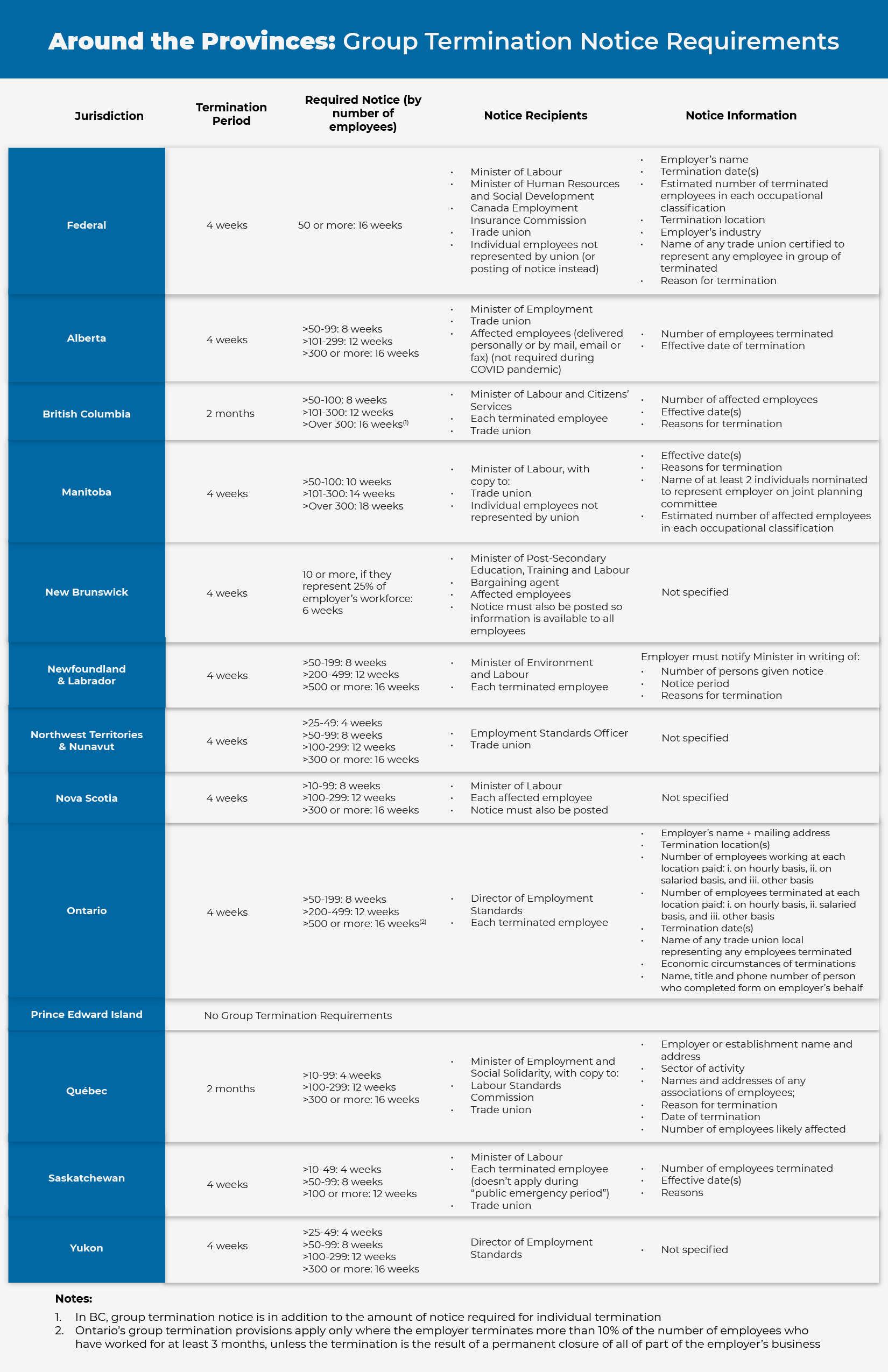Layoff & Restructuring: How to Comply with Group Termination Requirements

As we get deeper into the COVID-19 crisis, many businesses have or soon will reach a moment of decision: Can we afford to recall the employees we had to place on temporary layoff? Hopefully, your company can answer YES to that question. But if it can’t, you may be facing a new legal challenge: complying with the group termination requirements of your jurisdiction. And while employment standards SNAFUs are never a good thing, the potential costs of group termination violations increase exponentially because they impact so many employees, many if not most of whom have union representation. Here’s a rundown of the group termination requirements by jurisdiction.
| Defining Our Terms: The Difference between “Layoff” & “Group Termination”Although used interchangeably in the real world to refer to terminations affecting more than one employee, the terms “lay off” and “group termination” have different meanings under employment standards laws, with the former referring to temporary and the latter to permanent termination arrangements. This article is about “group termination but you can go to the HRI website for a Cheat Sheet analyzing temporary layoff requirements. |
What Is and Is Not a Group Termination
The first thing you need to be able to do is recognize when the restructuring you do and the pink slips you hand out constitute group terminations under the law. But that’s not as simple as it sounds, especially if you operate in more than one part of Canada. Thus, while all but one jurisdiction (PEI) imposes special rules for group termination, they all have slightly different definitions of group termination. To sort it all out, there are no fewer than 5 factors to consider:
Factor 1. Number of Employees Terminated
Group termination requirements are typically based on the number of employees terminated:
- 10: NB, NS, QC, SK;
- 25: the 3 territories; and
- 50: FED, AB, BC, MB, NL, SK. the threshold is only 10.
Factor 2. Which Employees Count in the Total
To calculate the number of employees terminated you also must know who to count. Thus, most jurisdictions exclude:
- Employees who’ve worked less than 3 months;
- Seasonal employees and those employed for a definite period or task; and/or
- Employees who’ve refused “reasonable” alternative employment.
Factor 3. Length of Time Over Which Terminations Occur
Group terminations don’t have to happen all at once. Instead, you count the number of terminations taking place over a particular time period. In 11 jurisdictions (Fed, AB, MB, NB, NL, NT, NU, NS, ON, SK and YT), the window is 4 weeks; in BC and QC, the window is 2 months.
Example: ABC Company terminates 3 employees per week over a 6-week period:
- No group termination in jurisdictions where the threshold is 50 terminations over 4 weeks (FED, AB, MB, NL, ON) nor in BC where the threshold is 50 over 2 months;
- Yes group termination in jurisdictions where the threshold is 10 employees over 4 weeks (NB, NS, SK) and in QC where it’s 10 over 2 months.
Special Extensions for COVID-19
In response to the pandemic, several jurisdictions have extended the maximum duration of temporary layoffs due to COVID-19, typically retroactive to a date when the outbreak began. Here’s a breakdown:

Note:
1. Extended deadlines in SK and NL apply to layoffs due not only to COVID-19 but any other emergency infectious illness
Factor 4. Whether Terminations Are Counted Business-Wide or By Facility
Calculating terminations gets tricky when terminations are spread out among different facilities. Fed, NS, ON, QC and SK count all employees within the employer’s “establishment,” which could include multiple facilities. Thus, employers in these jurisdictions may be unable to avoid reaching the threshold by spreading out terminations among different facilities. However, in AB and BC, the group termination number applies to terminations occurring within a single location.
Example: A BC employer who lays off 140 employees over a 2-month period can remain under the 50 employee threshold by spreading the layoffs out evenly among 3 different facilities. The other provinces and territories don’t say whether the number is based on the whole business or separate facilities. But experts say that termination would presumably be calculated company-wide unless expressly spelled out otherwise.
Factor 5. Whether Any Exceptions Apply
Employment standards law lay out exceptions when the group termination rules don’t apply. For example, in SK, employers don’t have to follow the group termination provisions for terminations caused by “unforeseeable events.” BC exempts certain industries, such as construction, fishing and fire fighting, from group termination rules. In ON, the group termination rules don’t apply regardless of how many employees are terminated as long as at least 90% of the workforce continues to work and the termination isn’t the result of a permanent shutdown of all or part of the employer’s business.
The 6 Things You Must Do to Comply
1. Give Extra Notice or Wages in Lieu of Notice
Unlike termination of individuals where notice is based on length of service, group termination notice is based on the number of employees terminated. Required notice for group termination is generally longer than notice for individual terminations—ranging anywhere from 4 to 18 weeks.
In most provinces, employers are allowed to overlap the notice periods. In other words, individual and group notice don’t count separately and employees get whichever notice is longer. But in at least one province—BC—the notice period for group terminations is in addition to the notice the individual is entitled to based on length of employment. In other words, the 2 notice periods are counted consecutively and don’t overlap.
Example: A BC machine operator with 2 years of service is let go as part of a group termination involving 150 employees:
- Individual Notice: 2 weeks;
- Group Notice: 12 weeks;
- Total Notice: 14 weeks.
In a province where the notice periods overlap (and employees with 2 years of service get 2 weeks of notice), e.g., SK, the same machine operator would get 12 weeks’ notice.
Another twist: For staggered terminations, 2 jurisdictions—BC and MB—require employers to give notice of termination to all terminated employees before the date the first employee is terminated. So, if a company initiates rolling lay offs, it must give the appropriate amount of notice in advance of the first wave. Thus, employees in the first wave will actually get more than the minimum notice required by law.
Example: A BC company announces that it will permanently lay off 500 employees over a 2-month period. The first wave will be let go on March 31; the rest will be terminated on May 31. The company must give all 500 employees notice of termination in mid-December (16 weeks before the first wave). So, employees in the first wave get 16 weeks’ notice and employees in the second wave 25.
2. Give Written Notice of Termination
Although it’s something you should probably do anyway, some provinces don’t require employers to give employees written notice of termination in individual terminations. But written notice is required for group terminations in most jurisdictions. Written notice must also list specific information, typically including:
- The effective date of termination (or terminations, if they’re staggered);
- The reasons for termination; and
- The total number of employees terminated.
Some jurisdictions require even more detailed information. For example, in MB, notice of termination must include the names of at least 2 people who may be the employer’s representatives on a joint planning committee. Regardless of what your jurisdiction requires, if the notice isn’t written properly, it won’t be effective. And if notice isn’t effective, employees will continue to earn wages until proper notice is provided and the additional service time they accrue after improper notice is served will have to be factored into the determination of how much notice they get.
3. Notify Third Parties
Upon group termination, employers must provide prior notice to not just the employees but third parties such as:
The Government: In every province except PEI, employers must alert the government about the group termination. In many cases, notice to the government is required even before the employer notifies the employees. For example, ON requires employers to complete a specific form and forward it to the Director of Employment Standards before giving notice to the affected employees.
Trade Unions: Nine jurisdictions—Fed, AB, BC, MB, NB, NT, NU, QC and SK—require employers to notify the terminated employees and/or their trade unions or bargaining agents. (Alberta has temporarily suspended this rule for COVID-19; Sask has done the same for not just COVID-19 but during any “public emergency period.”) And even if you’re not located in one of these jurisdictions, such notice is likely to be required under the terms of your collective agreements.
4. Post Notice
In addition to giving notice directly to trade union and employees, some jurisdictions, including Fed, MB, NB, ON and QC, require employers to post the termination notice in a conspicuous place where affected employees are likely to see it.
5. Form a Committee
Some jurisdictions also require employers to form a committee (usually called a joint planning or reclassification assistance committee) once they determine that a group termination is necessary. The purpose of the committee, which usually has an equal number of employer and employee representatives, is to determine whether terminations can be avoided. If the committee agrees that there are no realistic alternatives and that termination is necessary, it must establish methods for helping terminated employees obtain other employment. Some provinces, including BC, MB, ON and QC, don’t automatically require a joint planning committee but authorize the government to order the employer to form one at any time.
6. Consider Seeking a Waiver
Employment standards laws typically give employers the right to request a waiver exempting them from having to follow the group termination rules under certain conditions, e.g., because terminated employees are adequately protected by their collective agreement. But experts say that waivers are rarely granted and aren’t usually a viable option.
